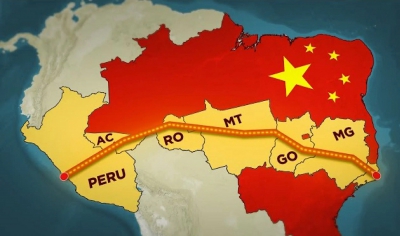
When mobile phone screens became the only source of light, when subway passengers escaped in the dark, and when global copper prices soared instantly - on February 25t, 2025, the most developed country in South America used the most primitive way to show the world the fragility of modern civilization.
12 Hours in Black
"When the sirens suddenly went off, I thought it was an earthquake drill," recalled Jose, a restaurant owner in downtown Santiago. At 15:16 on February 25th, 2025, 14 administrative regions in Chile fell into darkness at the same time, and 19 million people instantly returned to the "pre-electrical era".
"What happened today is outrageous! It is unacceptable that one or a few companies affect the daily lives of millions of Chileans, which is why the country has a responsibility to hold them accountable." Chilean President Gabriel Boric said in a televised address to the nation.

At the Capital Metro station, the emergency lights were only on for 3 minutes. Surveillance footage showed that in the crowded carriage, thousands of mobile phones lit up at the same time, forming a strange sea of blue light. Minister of Energy Juan Carlos made an urgent appeal: "Only 27% of the country's traffic lights are normal, this is not the time to go out!" But it was too late - in the video that went viral on social media, the intersection had turned into a giant parking lot, and the scene of traffic police directing traffic with whistles seemed like a century-old time travel.
The most dramatic scene occurred at Arturo Merino International Airport. When the check-in counter fell into darkness, the ground staff raised the rechargeable desk lamp and checked in passengers in the dim light. South America's busiest aviation hub now relies on 1980s-era generators to keep it running.
Dominoes: From power outage to "blood" disruption
"ATMs are all down, supermarkets only accept cash, but we can't even take out coins." The experience of writer Jorge reflects the fragility of the financial system. According to data from the Central Bank of Chile, the power outage caused the national electronic payment system to collapse. Only 25% of POS machines were able to conduct offline transactions. The bank run peaked at nightfall.
The more serious crisis comes from the lifeline project.
Water supply system: 70% of the pressurized pumping stations were out of service, forcing high-rise residents to walk downstairs to get water.
Medical system: 32 hospitals started using diesel generators, but operating room usage dropped by 85%.
Communication network: Mobile signal towers collectively "lost their voice", and the national network traffic plummeted to 25% of the daily level.
When night fell over the Andes, President Boric announced the launch of the "Shadow Plan": the army took over security and implemented curfews in 14 hardest-hit areas. The Chilean Ministry of National Defense has rarely disclosed that it has issued a "red alert" to border troops to prevent the flow of illegal immigrants who take advantage of the chaos to cross the border.

Copper Mine Shock: 'Cardiac Arrest' for Global Industry
"For every hour of power outage, global copper prices jump by 0.8%." Traders on the London Metal Exchange (LME) stared at the news from Chile, their fingers trembling on the keyboard. As the "Kingdom of Metals" that supplies 28% of global copper production, the collective shutdown of mining areas in northern Chile triggered a nuclear explosion-level impact.

In the Escondida copper mine at an altitude of 3,000 meters, a giant electric forklift worth tens of billions of dollars suddenly stood still. The suspension of production at the world's largest copper mine directly caused LME copper prices to soar to US$11,200 per ton, a record high. To make matters worse, although Anglo American's Los Bronces mine activated backup power, only 35% of its production capacity was restored.
"This is not a simple production interruption," mining analyst Maria pointed out. "Chilean copper mines generally use electric trucks, and a sudden power outage may cause permanent damage to the equipment." It is estimated that equipment repairs alone will cause losses of 300-700 million U.S. dollars, and the postponement of new mine production plans may rewrite the global copper supply pattern in the next five years.
500 kV fatal mistake: Who should pay for the disaster?
"It's like using a cotton thread to lift a thousand-kilogram weight." Electricity expert Dr. Sofia said of the Chilean power grid. The source of the fault was locked in the 500-kilovolt transmission line from the Atacama Desert to Santiago—this "main artery" that carries a quarter of the country's electricity. It unexpectedly caused an avalanche collapse due to the failure of the protection system.
Interchile S.A. became the target of public criticism. The transmission system operated by this Colombian company has been exposed to a 22% reduction in maintenance budget over the past three years. What's even more ironic is that the faulty line coincided with the transformation of the smart grid, and the loopholes in the connection between the old and new systems became fatal.
At this point, the deep crisis gradually surfaced.
1. Energy structure imbalance: Wind and solar power generation account for more than 40%, but supporting energy storage is insufficient.
2. Grid aging crisis: 35% of power transmission facilities are operating beyond their design life.
3. Geographical curse: 4,300 kilometers of land are divided by the Andes Mountains, forming three isolated power grids.
"We always say that Chile is the most developed country in Latin America," the energy minister said with a wry smile at the press conference, "but tonight, the way we light candles is no different from our grandmothers."
"We have built smart cities, but cannot untie the knot of high-voltage wires; we have invented digital currency, but cash is still the last line of defense." The Economist's comments hit the nail on the head. When Chilean people used their mobile phone flashlights to illuminate the subway passage, this glimmer of light in the 21st century not only illuminated the way to escape, but also illuminated the Achilles' heel of modern civilization.
Conclusion
After a 12-hour power outage, Chile lost more than just its light. From the congested intersections of Santiago to the beating numbers of the London Metal Exchange, this black storm reminds us that in an era of interconnected everything, no island can survive alone. Perhaps it's time to rethink the old adage - "Don't put all your eggs in one basket."










